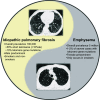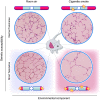Telomere-mediated lung disease
- PMID: 35532056
- PMCID: PMC9306791
- DOI: 10.1152/physrev.00046.2021
Telomere-mediated lung disease
Abstract
Parenchymal lung disease is the fourth leading cause of death in the United States; among the top causes, it continues on the rise. Telomeres and telomerase have historically been linked to cellular processes related to aging and cancer, but surprisingly, in the recent decade genetic discoveries have linked the most apparent manifestations of telomere and telomerase dysfunction in humans to the etiology of lung disease: both idiopathic pulmonary fibrosis (IPF) and emphysema. The short telomere defect is pervasive in a subset of IPF patients, and human IPF is the phenotype most intimately tied to germline defects in telomere maintenance. One-third of families with pulmonary fibrosis carry germline mutations in telomerase or other telomere maintenance genes, and one-half of patients with apparently sporadic IPF have short telomere length. Beyond explaining genetic susceptibility, short telomere length uncovers clinically relevant syndromic extrapulmonary disease, including a T-cell immunodeficiency and a propensity to myeloid malignancies. Recognition of this subset of patients who share a unifying molecular defect has provided a precision medicine paradigm wherein the telomere-mediated lung disease diagnosis provides more prognostic value than histopathology or multidisciplinary evaluation. Here, we critically evaluate this progress, emphasizing how the genetic findings put forth a new pathogenesis paradigm of age-related lung disease that links telomere abnormalities to alveolar stem senescence, remodeling, and defective gas exchange.
Keywords: emphysema; pulmonary fibrosis; senescence; stem cells; telomerase.
Conflict of interest statement
No conflicts of interest, financial or otherwise, are declared by the authors.
Figures










Similar articles
-
Telomerase and telomere length in pulmonary fibrosis.Am J Respir Cell Mol Biol. 2013 Aug;49(2):260-8. doi: 10.1165/rcmb.2012-0514OC. Am J Respir Cell Mol Biol. 2013. PMID: 23526226 Free PMC article. Clinical Trial.
-
From organ to cell: Multi-level telomere length assessment in patients with idiopathic pulmonary fibrosis.PLoS One. 2020 Jan 7;15(1):e0226785. doi: 10.1371/journal.pone.0226785. eCollection 2020. PLoS One. 2020. PMID: 31910222 Free PMC article.
-
[A concise review of telomere and telomerase-related genetic markers in fibrotic lung diseases].Zhonghua Lao Dong Wei Sheng Zhi Ye Bing Za Zhi. 2020 Dec 20;38(12):952-956. doi: 10.3760/cma.j.cn121094-20200305-00104. Zhonghua Lao Dong Wei Sheng Zhi Ye Bing Za Zhi. 2020. PMID: 33406566 Review. Chinese.
-
Telomerase treatment prevents lung profibrotic pathologies associated with physiological aging.J Cell Biol. 2020 Oct 5;219(10):e202002120. doi: 10.1083/jcb.202002120. J Cell Biol. 2020. PMID: 32777016 Free PMC article.
-
Telomeres in Interstitial Lung Disease: The Short and the Long of It.Ann Am Thorac Soc. 2019 Feb;16(2):175-181. doi: 10.1513/AnnalsATS.201808-508CME. Ann Am Thorac Soc. 2019. PMID: 30540921 Free PMC article. Review.
Cited by
-
Lung transplant recipients with telomere-mediated pulmonary fibrosis have increased risk for hematologic complications.Am J Transplant. 2023 Oct;23(10):1590-1602. doi: 10.1016/j.ajt.2023.06.014. Epub 2023 Jun 29. Am J Transplant. 2023. PMID: 37392813 Free PMC article.
-
Ratio of miRNA-29 to miRNA-199 expression coordinates mesenchymal stem cell repair of bleomycin-induced pulmonary injury.Mol Ther Nucleic Acids. 2025 Jan 21;36(1):102461. doi: 10.1016/j.omtn.2025.102461. eCollection 2025 Mar 11. Mol Ther Nucleic Acids. 2025. PMID: 40124162 Free PMC article.
-
Premature ageing of lung alveoli and bone marrow cells from Terc deficient mice with different telomere lengths.Sci Rep. 2025 Feb 19;15(1):6102. doi: 10.1038/s41598-025-90246-2. Sci Rep. 2025. PMID: 39971959 Free PMC article.
-
The Role of Telomeres in Human Disease.Annu Rev Genomics Hum Genet. 2022 Aug 31;23:363-381. doi: 10.1146/annurev-genom-010422-091101. Epub 2022 Jun 24. Annu Rev Genomics Hum Genet. 2022. PMID: 35609925 Free PMC article. Review.
-
Aging Lung: Molecular Drivers and Impact on Respiratory Diseases-A Narrative Clinical Review.Antioxidants (Basel). 2024 Dec 2;13(12):1480. doi: 10.3390/antiox13121480. Antioxidants (Basel). 2024. PMID: 39765809 Free PMC article. Review.
References
Publication types
MeSH terms
Substances
Grants and funding
LinkOut - more resources
Full Text Sources
Medical

